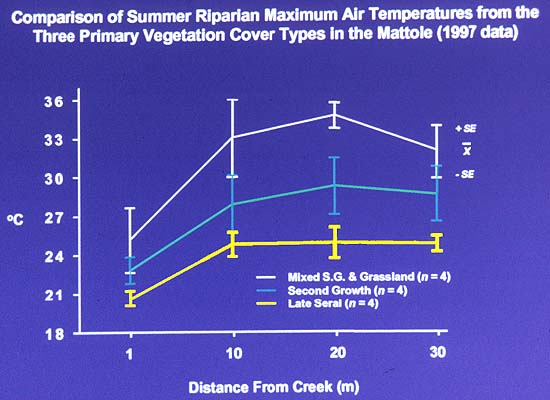 |
 |
Bibliography | Home |

The graph above shows the range of water and air temperatures relative to distance from the stream in three different forest habitats. Maximum summer air temperatures are much higher in mixed second growth and grassland and in second growth forests than in late seral forests. This in turn causes increases in water temperatures. Water temperatures in streams under late seral forest canopies generally range between 10-14 degrees C which is optimal for tailed frogs, torrent salamanders and coho salmon. See Riparian Conditions for more information on this topic.
![]()
Graphs and photographs from Dr. H. H. Welsh, Redwood Sciences Lab
From the Mattole River Basin:
Richness of amphibian species in 3 forest cover types (47 KB)
Air temperatures vs. distance from stream for three forest types (45 KB)
Abundance of Black Salamanders in perennial and intermittent streams (40 KB)
| Examples of the three forest cover types in the Mattole River basin: | ||
| Late seral | Second growth | Second growth and grassland mixed |
From regional studies:
Number of tailed frogs plotted against age of forest and air temperature (45 KB)
Abundance of So. torrent Salamander vs. % canopy (35 KB)
![]()
|
Table of Contents for Background Pages |
|||||
| Stream Conditions: | Water Quality | Sediment | Riparian | Big Wood | Habitat Types |
| Watershed Conditions: | Vegetation Types | Slope Stability | Roads & Erosion | Cumulative Impacts | Urbanization |
| Fish & Aquatic Life: | Fish Populations | Amphibians | Aquatic Insects | Hatcheries | Fish Disease |
| Restoration: | Stream Clearance | In-stream Structures | Riparian | Watershed | Strategy |
| Geology / Hydrology: | Geology | Soils | Precipitation | Stream Flow | Channel Processes |
| Policy & Regulation | ESA | TMDL | Forest Rules | 1603 Permits | Water Rights |
| www.krisweb.com |